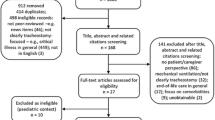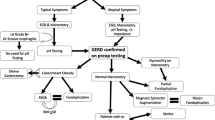Abstract
Background
Dysphagia is a common complication in stroke patients, which severely affects quality of life. This study aimed to evaluate the effectiveness and safety of temperature-controlled plasma radiofrequency (coblation)-assisted endoscopic cricopharyngeal myotomy (CAECPM) for the treatment sustained (>6 months) dysphagia in stroke patients.
Methods
This retrospective case-control study included a total of 24 stroke patients with sustained dysphagia, who were either treated with transcervical cricopharyngeal myotomy (CPM) (n = 16) or CAECPM (n = 12). The patients’ swallowing function was evaluated by the Chinese version of the swallow quality-of-life questionnaire (CSWAL-QOL), and dysphagia and aspiration was evaluated using the videofluoroscopic swallowing study (VFSS) swallowing (VFSS-SWAL) score and VSSF aspiration (VFSS-ASPI) score. In each patient, esophageal pressure and complications were also recorded.
Results
The CSWAL-QOL score was increased and the VFSS-SWAL and VFSS-ASPI scores were reduced after CAECPM treatment. The upper esophageal sphincter pressure was significantly reduced after CAECPM. Only 1 of 12 (8.3%) patients had subcutaneous and mediastinal emphysema, and 2 patients had gastric regurgitation.
Conclusion
This exploratory study demonstrates that CAECPM is worth further investigation for dysphagia after stroke. CAECPM may be an effective and safe treatment for sustained dysphagia in stroke patients. Larges and prospective studies are required to validate these results.





Similar content being viewed by others
References
Singh S, Hamdy S (2006) Dysphagia in stroke patients. Postgrad Med J 82:383–391
Yang J, Wang S, Zheng T, Zhou X, Shen Y (2011) An epidemiologic survey on nutritional status among post-stroke patients at community hospitals. J Neurosci Mental Health 11:239–242
Mann G, Hankey GJ, Cameron D (1999) Swallowing function after stroke: prognosis and prognostic factors at 6 months. Stroke 30:744–748
Smithard DG, O’Neill PA, England RE, Park CL, Wyatt R, Martin DF, Morris J (1997) The natural history of dysphagia following a stroke. Dysphagia 12:188–193
Kelly EA, Koszewski IJ, Jaradeh SS, Merati AL, Blumin JH, Bock JM (2013) Botulinum toxin injection for the treatment of upper esophageal sphincter dysfunction. Ann Otol Rhinol Laryngol 122:100–108
Finucane TE, Bynum JP (1996) Use of tube feeding to prevent aspiration pneumonia. Lancet 348:1421–1424
Bergeron JL, Chhetri DK (2014) Indications and outcomes of endoscopic CO2 laser cricopharyngeal myotomy. Laryngoscope 124:950–954
Zhu X, Yang H, Chen X, Jin Y, Fan Y (2011) Temperature-controlled radiofrequency-assisted endoscopic tonsillectomy and adenoidectomy in children. Lin Chung Er Bi Yan Hou Tou Jing Wai Ke Za Zhi 25:551–553
McHorney CA, Robbins J, Lomax K, Rosenbek JC, Chignell K, Kramer AE, Bricker DE (2002) The SWAL-QOL and SWAL-CARE outcomes tool for oropharyngeal dysphagia in adults: III. Document Reliab Valid. Dysphagia 17:97–114
Lam PM, Lai CK (2011) The validation of the Chinese version of the Swallow Quality-of-Life Questionnaire (SWAL-QOL) using exploratory and confirmatory factor analysis. Dysphagia 26:117–124
Frowen JJ, Cotton SM, Perry AR (2008) The stability, reliability, and validity of videofluoroscopy measures for patients with head and neck cancer. Dysphagia 23:348–363
Rosenbek JC, Robbins JA, Roecker EB, Coyle JL, Wood JL (1996) A penetration-aspiration scale. Dysphagia 11:93–98
Dauer E, Salassa J, Iuga L, Kasperbauer J (2006) Endoscopic laser vs open approach for cricopharyngeal myotomy. Otolaryngol Head Neck Surg 134:830–835
Halvorson DJ, Kuhn FA (1994) Transmucosal cricopharyngeal myotomy with the potassium-titanyl-phosphate laser in the treatment of cricopharyngeal dysmotility. Ann Otol Rhinol Laryngol 103:173–177
Kelly JH (2000) Management of upper esophageal sphincter disorders: indications and complications of myotomy. Am J Med 108(Suppl 4a):43s–46s
Takes RP, van den Hoogen FJ, Marres HA (2005) Endoscopic myotomy of the cricopharyngeal muscle with CO2 laser surgery. Head Neck 27:703–709
Kantor E, Berci G, Partlow E, Paz-Partlow M (1991) A completely new approach to microlaryngeal surgery. Laryngoscope 101:676–679
Jiebo G, Xiangmin Z, Zhenzhong S (2003) Application of video endoscope in laryngomicrosurgery. China J Endosc 6:008
Liu JB, Li M, Bai ZQ (2014) Clinical efficacy of suspension laryngeal endoscopy and powered laryngeal system in minimally invasive surgery. J Shandong Univ 28:74–76
Elbadawey MR, Hegazy HM, Eltahan AE, Powell J (2015) A randomised controlled trial of coblation, diode laser and cold dissection in paediatric tonsillectomy. J Laryngol Otol 129:1058–1063
Rakesh S, Anand TS, Payal G, Pranjal K (2012) A prospective, randomized, double-blind study of coblation versus dissection tonsillectomy in adult patients. Indian J Otolaryngol Head Neck Surg 64:290–294
Paramasivan VK, Arumugam SV, Kameswaran M (2012) Randomised comparative study of adenotonsillectomy by conventional and coblation method for children with obstructive sleep apnoea. Int J Pediatr Otorhinolaryngol 76:816–821
Wang J, Li W, Liu J, Xu C, Yang D, Huo H, Tian X, Zhang Z, Chen Y (2015) Surgical management of refractory dysphagia and aspiration. Zhonghua Er Bi Yan Hou Tou Jing Wai Ke Za Zhi 50:89–94
Bachy V, Matar N, Remacle M, Jamart J, Lawson G (2013) Long-term functional results after endoscopic cricopharyngeal myotomy with CO2 laser: a retrospective study of 32 cases. Eur Arch Oto-Rhino-Laryngol 270:965–968
Acknowledgement
This study was supported by a grant from the National Natural Science Foundation (No: H1301 81300816).
Author information
Authors and Affiliations
Corresponding author
Ethics declarations
Conflict of interest
Jian Wang, Wuyi Li, Yongjin Li, Xiaofeng Jin, Yanyan Niu, Xu Tian, and Hong Huo declare that they have no conflicts of interest or financial ties to disclose.
Rights and permissions
About this article
Cite this article
Wang, J., Li, W., Li, Y. et al. A novel endoscopic surgery for dysphagia after stroke. Surg Endosc 32, 127–133 (2018). https://doi.org/10.1007/s00464-017-5647-1
Received:
Accepted:
Published:
Issue Date:
DOI: https://doi.org/10.1007/s00464-017-5647-1




